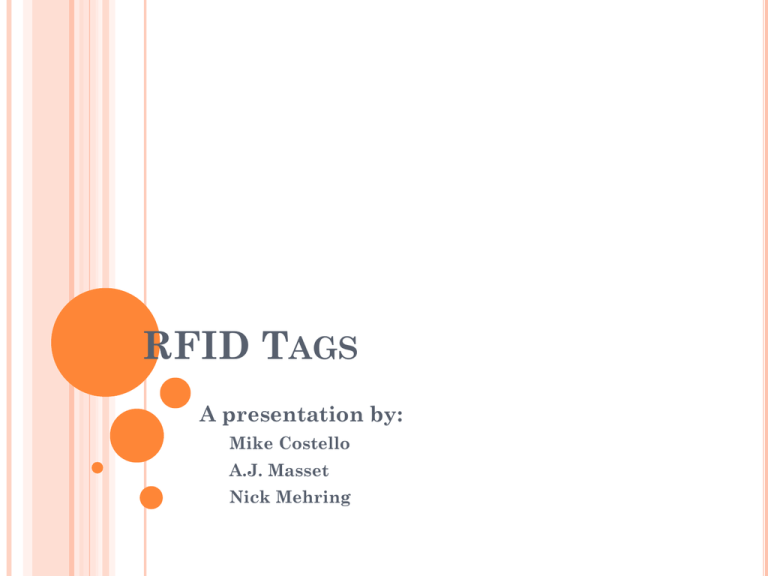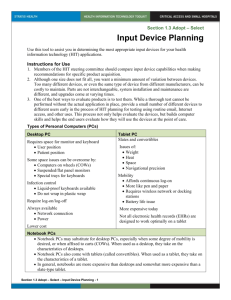RFID Tags - WordPress.com
advertisement

RFID TAGS A presentation by: Mike Costello A.J. Masset Nick Mehring THESIS Radio Frequency Identification (RFID) technology is widely used today and has many potential uses in the future. CONTENTS Introduction Technology background History Today’s usage Potential usage Pros Cons RFID TAGS A technology that uses communication via radio waves to exchange data between a reader and an electronic tag attached to an object, for the purpose of identification and tracking. RFID TAGS CONT. Radio-frequency identification involves a few components: Interrogators (known as readers) Tags (known as labels) Integrated circuit for storing/processing data Antenna for receiving/transmitting a signal RFID software or middleware RFID TAGS CONT. Three types: Passive Using no battery Active Using battery (always beaconing signal) Can be read from farther distances Battery Assisted Passive (BAP) Small battery onboard activated in presence of reader RFID TAGS CONT. Read Only Memory is factory programmed, cannot be modified Very limited quantity of data can be stored, usually 96 bits Can be easily integrated with data collection systems Typically cheaper than read-write tags Read-Write Can be as well read as written to Data is dynamically altered Can store a larger amount of data, typically ranging from 32 kBytes to 128 kBytes More expensive HOW IT WORKS CONT. Passive Tags RFID tag passes through presence of scanner and detects activation signal Radio waves are sent from reader to tag Coiled antenna within the tag forms a magnetic field Tag draws power and energizes circuits in the tag and sends information encoded in memory HOW IT WORKS Active Tags Batteries power circuits to send radio waves to a reader from an antenna on the tag (like a cell phone to a base station) Reader’s antenna receives information to be stored HOW IT WORKS CONT. Battery Assisted Passive (BAP) Tag Battery used to maintain memory in the tag or power the electronics that enable the tag to modulate the reflected signal Acts same as passive when communicating HOW IT WORKS CONT. HISTORY Traced back to WWII Warn of approaching planes First patent for an RFID tag was in 1973 Active tag, rewritable memory Same year, passive transponder was used to unlock a door without a key CURRENT USAGE Inventory tracking http://www.youtube.com/watch?v=4Zj7txoDxbE Race timing Pay tolls (EZ-Pass) Passports Pet doors Tracking devices Hospitals Refigerators Casino chips MERCHANDISE RFID tags on clothes, CDs, movies, etc. Reader at door Alarm sounds when not deactivated at register RACE TIMING Timing is everything Active and Passive Boston Marathon Checkpoints EZ-PASS Electronic toll collection system Drive through tolls without stopping Automatically takes money out of account RFID mounted behind rear-view mirror Antenna mounted above road PASSPORT Chip contains persons information Name, nationality, gender, DOB, POB, digital photo RFID matches paper More difficult for tampering Encrypted digital signatures Can break the RFID chip with a hammer Doesn’t invalidate the passport PET DOOR RFID tag on pets Reader on door Allow pet to go in and out Will not allow foreign pets in (neighbor’s pets can’t eat your pet’s food) JAPAN TRACKS KIDS RFID tags on school children’s backpacks in Osaka Readers mounted on the doors Unauthorized visitors will be denied access Track movements of minors Allows parents to know their kids got to school safely via mobile phone FULHAM FOOTBALL CLUB Cards with RFID given to season ticket holders Contains info about paid games Can update card via phone or computer If stolen, unique code will deactivate card, and new one may be purchased Cut lines at turnstiles Went from 10-20 seconds to 4 seconds per ticket Increases safety Nearby roads are now empty on game days due to decrease in lines HOSPITALS New York and Germany Tagging patients Bracelets are scanned by doctors Patient records, correct dosage of drugs Tagging blood Right blood reaches right person SAMSUNG REFRIGERATOR Samsung RFID enables refrigerator Tells current contents of fridge Can tell what you are low on Displays recipes that you currently have stocked Working on displaying info on laptop/phone Predicted that when TV’s are RFID, custom commercials will be displayed by what is low in the fridge LAS VEGAS CASINOS RFID imbedded in high value chips Readers around casino Prevents counterfeiting, stealing Track betting patterns Decrease dealer errors CURRENT SECURITY Encryption Tin foil method Passport case IBM COMMERCIAL http://www.youtube.com/watch?v=eob532iEpqk& playnext=1&list=PL1E873E327447330F Very controversial Privacy laws updated Security is a huge concern + POSSIBLE TECHNOLOGIES Own home Temperature/scents of each room Music, TV Programs. Already in use Given to guests as necklace POSSIBLE TECHNOLOGIES CONT. Washing Machines, automatic washing. Use in paper money it eliminate counterfeit and track criminals Cash just as traceable as credit card if linked to drivers license POSSIBLE TECHNOLOGIES Use on produce, track shopping trends. Stores write information to your drivers license or credit card RFID. Easily track food force source, making food supply chain much safer POSSIBLE TECHNOLOGIES CONT. Uses in roads to prevent accidents. Automatic driving? Gun control, registration RELATION TO IS Database usage Middleware is used Security measures Rapidly growing field SOURCES http://www.buzzle.com/articles/amazing-rfid-8current-uses-of-radio-frequencyidentification.html http://www.silicon.com/technology/networks/2006 /11/30/top-10-the-best-worst-and-craziest-uses-ofrfid-39164446/ http://www.traserproject.eu/documents/RFID_MITIP2006.pdf http://www.readwriteweb.com/archives/100_uses_ of_rfid.php http://www.rfidjournal.com/article/view/1338 QUESTIONS




